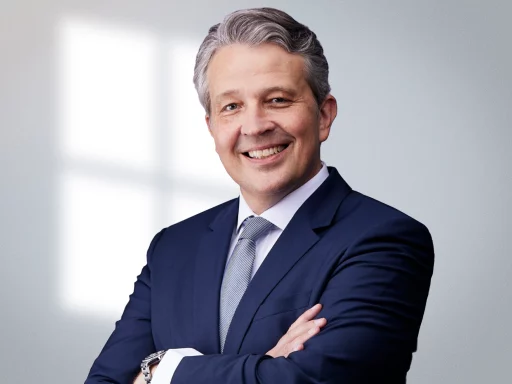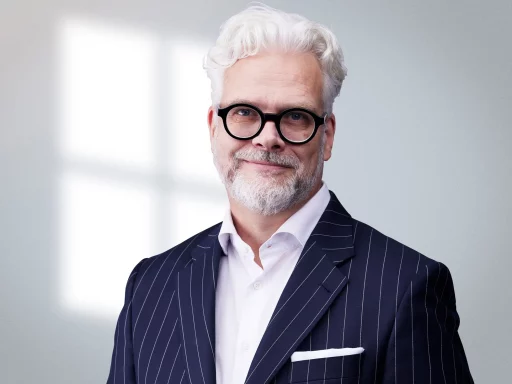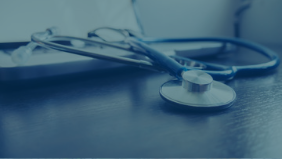What is driving the healthcare market in the DACH region:
M&A transactions in 2024 and outlook for 2025
Magnus Höfer, Dr. Christopher Klein, Christoph Osterbrink
1. Introduction
In 2024, the healthcare market in the D-A-CH region (Germany-Austria-Switzerland) continued to be driven by similar developments and trends as in the previous year. Technological advances in areas such as cell and gene therapy, artificial intelligence, digital health solutions and process innovations (e.g., robotics or 3D printing) led to new treatment methods and increasingly personalized products. In contrast, regulatory requirements, including the Supply Chain Due Diligence Act, the EU Critical Medicines Act and the divergent standards for medical devices between the EU, UK and US, had a predominantly inhibitory effect on innovation and growth. In addition, the macroeconomic situation, with falling interest rates but rising spreads, created a subdued investment climate. Many market players continued to be risk-averse, which means that the industry has not fully returned to its previous momentum.
Steinbeis M&A analyzed the M&A activity of the healthcare sector in the DACH region, where almost 300 transactions with at least one party based in this region could be identified. The published transaction volume with DACH target companies totaled more than EUR 7 billion, which is below the 2023 level. In particular, the sale of MorphoSys in spring 2024 had a significant impact on the total volume. While the “Pharma & Biotech” sector recorded the highest aggregated deal volume, “Medtech & Digital Health” accounted for about half of all transactions.

Figure 1: Evaluation Steinbeis M&A, based on data from PitchBook
A comparative look at the upstream VC market seems interesting: here, the number of financing rounds in the DACH region that we identified was down year-on-year at just under 400, with “Medtech & Digital Health” accounting for the largest share. The good news was the doubling of the capital raised to around EUR 2.5 billion, driven by the biotechnology sector. Two-thirds of the capital went to companies based in/near Munich, Basle and Lake Geneva, which demonstrates the importance of location in terms of infrastructure, personnel and networking (networks of biotechnology and large pharmaceutical companies)! These figures illustrate the problems of financing and the survival of young start-ups, while strategic and institutional investors are increasingly seeking greater security and are only willing to get involved at later stages – but then often with larger tickets. It is interesting to note that almost the same number of financing rounds were completed in Germany and Switzerland despite the difference in terms of country size/their populations. It is therefore not surprising that one and a half times as much funding was raised in Switzerland as in Germany.
This is a clear indication of the unfavorable conditions for start-ups in Germany, and unfortunately, little has improved in this regard in recent years – or rather, decades. Against this backdrop, corporate strategy, the tactics of young companies in raising fresh capital, and good contacts in the investor world are even more crucial.
2. Transactions in the “Pharma & Biotech” sector
In 2024, significant transactions were attributable to pharmaceutical and biotechnology players of the DACH region.
For example, big pharma company Novartis engaged in a remarkably high level of M&A activity during 2024, as demonstrated by four significant deals with MorphoSys, Calypso, IFM Due and Kate. The Bavarian company MorphoSys, a well-known oncology player, brings Pelabresib in the fight against myelofibrosis and was worth USD 2.7 billion to the buyer. Shortly before that, Novartis had acquired the East Coast company IFM Due for USD 835 million to strengthen its pipeline in immuno-oncology and autoimmune diseases. Geneva-based Calypso Biotech is working on the same range of indications with its lead product CALY-002 for the treatment of celiac disease and other inflammatory disorders, which Novartis was willing to invest CHF 380 million for. In the summer, the acquisition of the West Coast company Kate Therapeutics for USD 950 million, which focuses on gene therapies for musculoskeletal diseases, followed. This underscores the continued attractiveness of orphan drugs and their upward trend.
In January 2024, Basle-based Roche completed the year’s largest DACH deal, acquiring Carmot Therapeutics for USD 3.3 billion. This acquisition gives Roche access to Carmot’s research and development portfolio for the treatment of obesity and type 2 diabetes. Here, Roche is competing with the already established GLP1 receptor agonists dulaglutide (Eli Lilly’s Trilicity) and semaglutide (Novo Nordisk‘s Ozempic). The latter company also broke new ground by entering the field of cardiovascular diseases. The Danes did this by acquiring Hanover-based Cardior Pharmaceuticals, along with its clinical RNA therapeutic for heart failure, for EUR 1.0 billion.
The German Mittelstand was also encouragingly active in terms of portfolio and market presence, often with US ties. In 2024, Frankfurt-based Merz Therapeutics completed the acquisition of Acorda Therapeutics for USD 185 million, securing Inbrija (levodopa) and Fampyra (fampridine). This acquisition expands Merz‘s neurology portfolio and strengthens its position in the US, particularly in the areas of Parkinson’s disease and multiple sclerosis. The Germans plan to increase their US workforce by more than half to support growth in these therapeutic areas. Also in the United States, Grünenthal purchased Valinor Pharma, along with its product Movanti (naloxegol), which is used to treat opioid-induced constipation in adults with chronic, non-cancer pain, for USD 250 million. As part of a Berlin deal, Glycotope – a developer of antibodies against tumor-specific antigens – was acquired by Eckert & Ziegler. This acquisition allows the latter to expand its activities in the field of radiopharmaceuticals and to develop innovative oncology therapies through its PentixaPharm subsidiary. Finally, Dr. Falk Pharma bought the Scottish company Kynos Therapeutics, which develops novel treatments for patients with acute and chronic inflammatory diseases such as acute pancreatitis, a perfect fit for the Freiburg-based company’s positioning as an expert in gastrointestinal diseases.
Compared to strategic investors, private equity was noticeably restrained in making new investments last year, instead investing mostly into or for, existing portfolio companies. For example, Tübingen-based SHS invested a further EUR 10 million in its 2020 investment Develco Pharma, a specialist in the development and manufacture of innovative sustained-release drugs. With Advent behind it, the generics company Zentiva, formerly Sanofi-Winthrop, took over Paragon’s shares in stock-listed Apontis Pharma, formerly Schwarz Pharma, and made a public takeover bid for the remaining shares for a total of EUR 85 million. With Apontis as a specialist in so-called single pills – combination products to improve patient compliance in chronic diseases – Zentiva is strengthening its portfolio in cardiovascular diseases and opening up a new area with these single-pill therapies. Supported by its majority shareholder Silver Investment Partners, Saarland-based GPW Group, a leading distributor of non-listed pharmaceuticals, is expanding into the Benelux region with the acquisition of Dutch-German pharmaceutical wholesaler Orly Pharma. In 2021, Impilo acquired the Danish preclinical contract research organization Scantox, with the aim of strategic expansion. Scantox has now taken over Austrian company QPS Neuro to expand its expertise in the field of central nervous system research. Finally, the following new PE investments are worthy of mention: the Lian Group‘s investment in Geneva-based cosmeceuticals company Scientis Pharma, Monacum Partners’ investment in Westphalia-based API manufacturer Evotec DS, and French company Abenex’s investment in Lake Zurich-based dietary supplement specialist Santis Pharma.
Analogous to private equity, venture capital activity for new and young players was rather sluggish. All the more impressive were the fireworks in over a dozen late-stage financing rounds above the € 50 million mark. Swiss Alentis Therapeutics (Series D with USD 181 million), Noema Pharma (Series B with CHF 150 million), CatalYm (Series D with USD 150 million) and Tubulis (Series B2 with EUR 128 million) were at the top of the list. Regarding future exits, the prospect of successful IPOs such as Biontech, Evotec and Formycon, as well as strategic sales within Europe such as MorphoSys, Cardior and Apontis, may be encouraging.
3. Deals in the “Medtech & Digital Health” sector
There were also some notable transactions with regards to medical and related digital technologies in the DACH region:
In January 2024, the world’s leading prosthesis and orthosis manufacturer Össur, acquired the Lüneburg-based orthopedic technology company FIOR & Gentz, with the subsequent establishment of the parent company Embla Medical. The purchase price was EUR 120 million, which corresponds to an EBIT multiple of approximately 20.
After the Viessmann family had sold its air-conditioning business for EUR 12 billion in 2023, the Viessmann Generations Group took a stake in the consortium of shareholders of the Schülke & Mayr Group from Norderstedt near Hamburg, a global provider of infection prevention, which in turn is controlled by the Munich-based single family office ATHOS of the Strüngmann brothers, and Bitburger Holding.
Private equity investor Cinven sold an indirect minority stake of 15% in diagnostic service provider Synlab to Labcorp, a US provider of various laboratory services, for EUR 140 million. At the same time, Cinven initiated the squeeze-out of the remaining minority shareholders in order to control 100% of Synlab shares. Prior to this, Cinven had already sold Synlab’s clinical diagnostics business in Spain to Eurofins and successfully completed a EUR 1 billion refinancing round.
The family-run medical technology company Karl Storz from Tuttlingen continued its M&A growth course with four transactions in 2024: In January, it acquired a stake in the British AI specialist Innersight Labs. In April, it acquired the business of its distributor Stöpler in the Benelux region. Three months later, Karl Storz announced the acquisition of medi G, a Meßkirch-based provider of instruments for minimally invasive surgery. Finally, in August, robotics specialist Asensus Surgical was acquired in the US for EUR 108 million. An impressive achievement by Marc Jacob and his team, knowing that more deals are in the pipeline for 2025 and that others have already been completed at the beginning of 2025!
The German company SPIGGLE & THEIS Medizintechnik, a portfolio company of Thyssen’sche Handelsgesellschaft, expanded its portfolio with surgical instruments in the ENT field by acquiring Bryan Medical, thereby also strengthening its market presence in the United States.
Another active player is the Swedish Asker Healthcare Group, which was again able to carry out several acquisitions during 2024 and now has over 40 companies in its portfolio. In the DACH region, Praximedico, a specialized distributor of medical devices and reimbursement software in the nursing home sector from Switzerland, Hauser Medizintechnik, a distributor of medical furniture and disposable products for hospitals in Austria, and meetB, a distributor of medical technology in the field of emergency medicine in Brandenburg, were acquired.
Institut Straumann also continued to pursue its M&A strategy consistently in order to expand its capabilities in the field of digital dentistry and to strengthen its presence in selective markets. In 2024, the two Eastern European dental dealers Schmidt Dental from Poland and Med grup from Lithuania, as well as the dental surgery software developer Mininavident from Switzerland, were integrated into Straumann Group.
4. Noteworthy transactions in the “Patient & Elderly Care” sector
One of the most prominent deals in hospitals and clinics was the sale of a majority interest in the post-acute business, in particular rehabilitation clinics, of the Austrian company VAMED to the private equity firm PAI Partners for EUR 570 million. This will create a new, independent, internationally active market player with around 13,000 employees, which will certainly continue to grow inorganically.
In the sub-segment outpatient care / medical care centers (MVZs), the consolidation continues – driven by financial investors and their capital needs. We continued to observe regular transactions here. These primarily took place in the fields of radiology (Rad-x with Gilde Healthcare, ADUS Radiologie and Radiologie Hofheim/Taunus), dermatology (PsoriSol and MVZ Derma Cologne), orthopedics and dental (dental practices and laboratories). We expect transaction activity to continue here, but it will certainly be more selective. The reasons for this are the uncertain political environment, especially before the German elections, and the uncertainty regarding the subsequent exit or possible exit valuations.
The geriatric care sector – both care facilities and outpatient service providers – remains difficult for strategic and financial investors. Although there were a large number of transactions in 2024, unfortunately these were mostly restructurings and local or regional transactions resulting from insolvencies. For structural reasons, skepticism about this sector is also indicated for 2025, even though nursing is one of the biggest challenges for an aging society and healthcare systems, since the costs for personnel, energy, etc., which have risen sharply in some cases, combined with an acute shortage of specialist staff, cannot be offset by increased nursing rates and additional payments.
5. Outlook on important trends for M&A activities in the healthcare market with a focus on DACH region and Europe
We expect the following trends to play an important role:
- Corporate succession: We continue to see corporate succession as a very high priority. In all segments of the healthcare market, generational change is imminent, combined with the overdue transformation of formerly successful business models.
- Increasing specialization: Regional specializations will shape the innovation landscape in the pharmaceutical industry, with North America leading in advanced biologics and AI-based drug development, Europe leading in sustainable production and rare diseases, and Asia leading in the manufacturing of generics and biologics.
- Focus on clinical assets: Investments will continue to be concentrated on companies with strong clinical data in advanced phases of clinical trials, both in traditional indication areas such as oncology and in more novel areas such as endocrinology with obesity and diabetes.
- Personalized, individualized therapies in oncology: The focus on genetic profiles and individual disease progression will continue to enable more precise and effective treatment approaches in the future.
- Consolidation in digital health: The number of digital health unicorns is expected to decrease due to increased M&A and IPO activity. Subsegments such as chronic disease management and digital therapeutics will be particularly relevant for M&A transactions.
- Increasing importance of carve-outs: In view of the reduced number of transactions, carve-outs and public-to-private deals will attract investors looking for scalable assets with potential for value creation.
- The DACH region is at risk of being left behind. Overregulation, a shortage of skilled workers and high energy prices are causing investors to be cautious. Nevertheless, the DACH region remains an attractive market, even though other regions are developing more dynamically in terms of innovation, growth and valuation.






